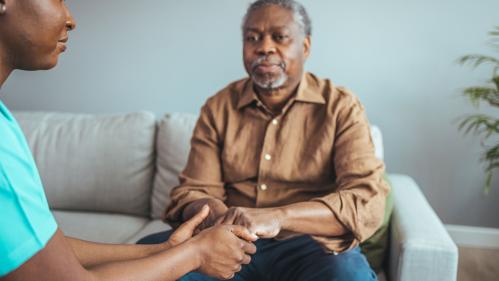As the Older Americans Act Nears 60, Ageism Remains Pervasive

The Hub for Aging Collaboration at Rutgers is working toward a more age-inclusive society
When President Lyndon B. Johnson signed the Older Americans Act (OAA) into law on July 14, 1965, he predicted the legislation “will help us to expand our opportunities for enriching the lives of all of our citizens in this country, now and in the years to come.”
But in the nearly six decades since then, many states have failed to deliver the benefits for older Americans that Johnson envisioned. Today, about one in three seniors are economically insecure and nearly 7 percent of adults older than 60 face the threat of hunger.
Emily A. Greenfield is an expert within a growing movement to transform societal contexts for aging, including efforts to modernize the Older Americans Act. A professor at the Rutgers School of Social Work, she is director of the Hub for Aging Collaboration at Rutgers. Lauren Snedeker is an assistant professor of teaching in the School of Social Work and a licensed social worker in private practice with older adults.
The two discuss the legacy of the OAA and how Rutgers is working to enhance opportunities for individuals, families and communities as they age.
This month marks the 58th anniversary of the Older Americans Act. What was the Act meant to do, and how well has it achieved its goals?
Greenfield: The Older Americans Act was intended to be a focal point of the Great Society reforms – right alongside Medicare and Medicaid – aimed at ending poverty, improving environments and promoting civil rights. Medicaid and Medicare were designed as health insurance programs for older adults and people in poverty, and the OAA was meant to cover community-based services for older adults – like social services and nutrition assistance.
But straight out of the gate, the OAA wasn’t funded adequately. A federal piece of legislation designed to provide many different types of services to older Americans – people over 60 – is a very ambitious undertaking. And while it historically has received bipartisan support, it has never been properly funded. In this past fiscal year, it received less than $2.4 billion. This contrasts with over $800 billion in spending through Medicare.
The Older Americans Act put a lot of responsibility on states. How does it work – and how has New Jersey done?
Greenfield: States get federal money, and those funds are then allocated to regional offices on aging, but the scope and quality of services that these regional offices provide varies widely.
In New Jersey, aging policy is in many ways overlooked with some notable exceptions – like the state pension system and age-based property tax relief. There's a perception that once you hit a certain age, you leave New Jersey because of the high cost of living, issues with livability and the design of our communities. Still, a lot of people do age in New Jersey. For some, it’s by choice: People don't want to abandon their communities of many, many years. But for others, it's a necessity. They really can't afford to pick up and leave.
We're trying to start a conversation and work with others to raise awareness on the need for greater public, private and civic leadership for a massive segment of New Jersey's population. Some counties amplify their funding to help people as they age. Other counties don't give anything beyond what the federal and state government provides. That's, in part, the focus of my research – to understand the municipal muscle for supporting aging services at the very local level. People’s taxes pay for schools. What's the parallel for older Americans?
These are big questions. How would you answer them?
Greenfield: Attention to aging doesn't just happen without the deliberate allocation of resources – both financial and nonfinancial. Negative assumptions about people based on their age is called ageism. It’s structural and characteristic of the society in which we live. Ageism is oftentimes overlooked as an “ism” within diversity, equity and inclusion initiatives, and considerations of aging outside of major national spending programs, like Medicare and Social Security, haven’t really been elevated in mainstream policy conversations. And so, that’s in large part the reason we created the Hub for Aging Collaboration at Rutgers.
What is the Hub, and what is it doing?
Greenfield: Launched in October 2022, the Hub is a new enterprise that is creating a sharpened focus on aging-related work within Rutgers.
A lot of centers on aging are wired around the research component. Their primary goal is to get grant funded projects for research. That's an important part of what we're doing. But we're the Hub for Aging Collaboration. We're building something that cuts across all elements of higher education in a balanced way – research, teaching and partnerships with people both inside and outside the university. We want to focus on collaborating with others to create social change for aging broadly.
How does teaching fit in?
Snedeker: To dismantle ageism, individuals must understand what it is, how it impacts people, and what can be done to reframe the aging experience throughout the lifespan. It is incredibly important to include content on ageism in courses and how it can influence professional practice. For example, I help facilitate conversations with social work students on the ways ageism shows up in the therapy room. Having these conversations helps students to become more empathetic and compassionate toward people of all ages, including older adults, as they deal with mental health challenges.
What are other ways the Hub is working to address ageism?
Greenfield: Promoting age inclusion is something that cuts across our work. For example, the Age-Friendly Research Team at the Hub is working to advance age-friendly community initiatives in New Jersey, and our research focuses on understanding how these initiatives develop and advance social change on aging in local communities.
As co-administrators of Age-Friendly North Jersey, the team also cultivates a community of practice by providing platforms for age-friendly community leaders to share and learn from each other. An example was our dreaming up and implementing the 2022 New Jersey Age-Friendly Virtual Fair, which featured over 30 breakout presentations on a variety of topics related to age-friendly communities, as well as remarks from state government and higher education leaders.
Snedeker: In addition to teaching social work students here at Rutgers on aging, I also lead university-wide efforts on age inclusion alongside affiliate members of the Hub. This past year, Tracy Davis of the Rutgers School of Health Professions and I were awarded an IDEA Innovation Grant from the Division on Diversity, Inclusion and Community Engagement at Rutgers-New Brunswick. Our work first set out to understand faculty impressions about ageism and relevant content in their courses. We are now creating a toolkit of resources to support instruction on ageism at Rutgers.
What’s the most important thing for people to know about the Hub?
Greenfield: The Hub demonstrates ways in which higher education can lead with its strengths across research, teaching and service to amplify collaborative action for social change. We want to position our work to modernize social policies, like the Older Americans Act, and advance innovation to translate aspirational visions for aging societies into effective and equitable on-the-ground practices.
Snedeker: I consider the Hub to be the mothership at this point. Faculty, students, staff, professionals and other individuals are welcomed to join the work from wherever they are, in whatever way makes sense to them. Through the Hub, people can learn, grow, connect and contribute to making our world a better place to age.



